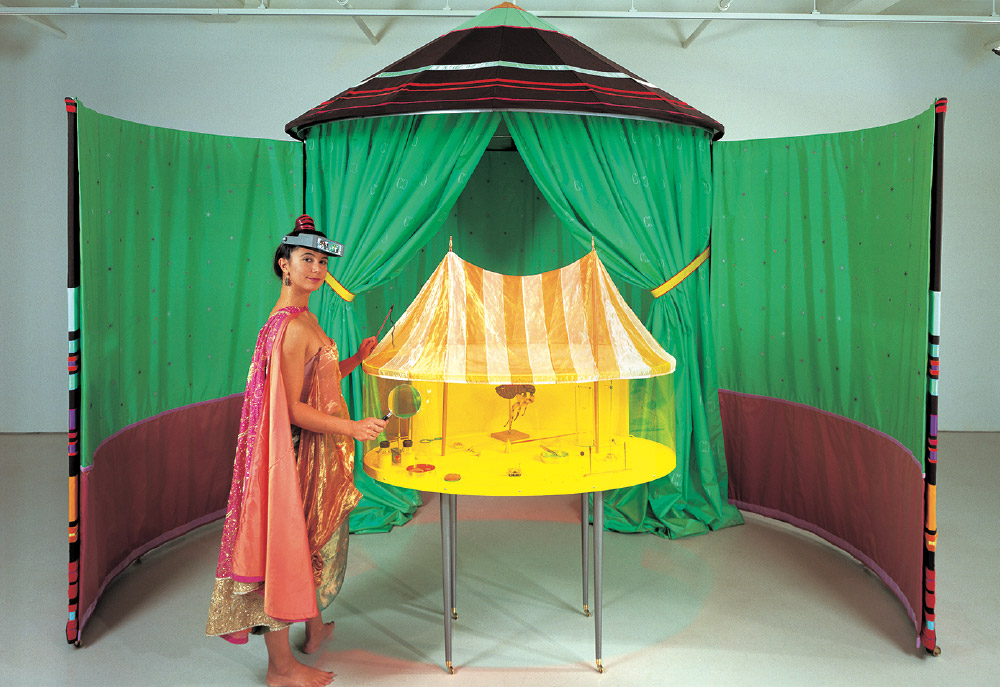Lesson 1: Design a Performance Space
Some artists-in-residence at The Fabric Workshop and Museum present their artwork in theatrical and performance-like ways. They may change the gallery spaces by constructing an installation or a performance space, which they use for presenting performance art with an audience. The following activity can be a stand-alone lesson, or a part of a larger unit of study.
Objectives
- Students will look at, think about, and discuss contemporary art.
- Students will think creatively and critically about architectural space and design.
- Students will work collaboratively to construct a three-dimensional model of a performance space.
Materials and Resources
- Background information and photographs of Cardoso Flea Circus (1996) by Maria Fernanda Cardoso (See New Materials as New Media by Marion Boulton Stroud, 2002, The M.I.T. Press, Cambridge, MA, pages 66-71.)
- Cardoso Flea Circus video (Found in the media area above, #4)
- Wooden dowels
- Balsa wood
- Straws
- String, yarn
- Foamcore board or cardboard
- Cardboard boxes (for pedestals)
- White glue
- Pencils, writing paper
- Magazines
- Colored tissue paper
- Scissors
- Rulers
Activities
- As a class, view photographs of Cardoso Flea Circus, a performance space created by Maria Fernanda Cardoso for her performances with fleas. Ask students to describe the colors, materials and construction of the performance space and Cardoso’s costume.
- As a class, view and discuss Cardoso Flea Circus, a video of Cardoso performing with her flea circus.
- What tricks did they perform together?
- How are the fleas like human circus acrobats?
- How did Cardozo direct the performance?
- Describe the sizes of the fleas and their human director. How does the contrast of sizes affect our responses to the performance?
- Brainstorm other types of performances that students enjoy, for example, dancing, sports, concerts, musicals, and movies.
- Have each student write about an imaginary performance, describing who performs, what happens, where it takes place and what the performance space looks like.
- Divide students into small groups. Help the groups share their imaginary performance ideas, then choose and agree upon a type of performance and performance space to construct.
- Help students work collaboratively to construct models for imaginary performance spaces:
- Provide art materials (listed above) and demonstrate possible ways of using them.
- Have students determine the construction tasks involved and delegate the tasks to group members.
- After the performance space models are completed, have each group discuss and describe how a performance would take place there. Who are the performers and the director? What happens? Is there music playing? Assign one student in each group the task of recording this information.
Reflection and Evaluation
- Set up a display of the performance space models.
- Have each group of students present their model and describe an imaginary performance, including the director and performers.
- Ask students to come up with constructive responses to the presentations. For example, “I like the way you built and decorated the walls for your space with cardboard. They look strong and colorful.”
National Standards
- Content Standard #1 (Understanding and applying media, techniques, and processes)
- Content Standard #2 (Using knowledge of structures and functions)
- Content Standard #3 (Choosing and evaluating a range of subject matter, symbols, and ideas)
- Content Standard #4 (Understanding the visual arts in relation to history and culture.)
- Content Standard #5 (Reflecting upon and assessing the characteristics and merits of their work and the work of others)
Vocabulary
- Installation: An ensemble or environment, sometimes created for a particular gallery or outdoor site that provides the experience of being surrounded by art. Because many installations are temporary, often only photographs or videos remain to document their existence.
- Performance art: Art activities that are presented before a live audience and that may involve music, dance, theater, and video.
Curriculum Connections
- Language Arts
Imagine what it would be like to be a flea performing in a flea circus. Write a short story about your experiences. - Math
Determine an appropriate scale for a scale model of an imaginary performance space, for example, one inch = one foot. - Social Studies
Research the history of flea circuses. - Science
What makes the fleas do what they do? Find out how flea circuses really work. - Art
Study the illustrations in Two Bad Ants by Chris van Allsburg. How is an ant’s perspective different from yours? Make a drawing of a flea circus from the perspective of a flea.
